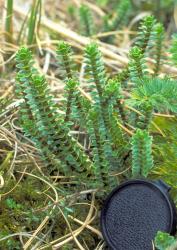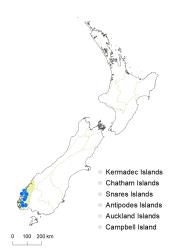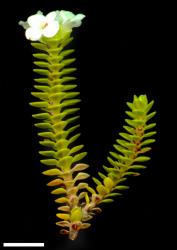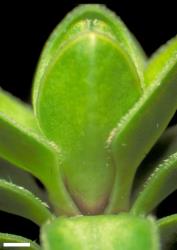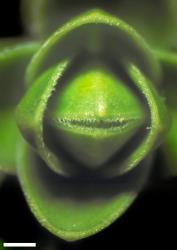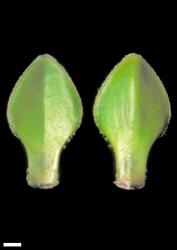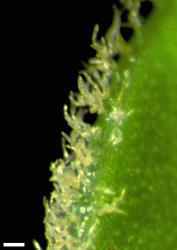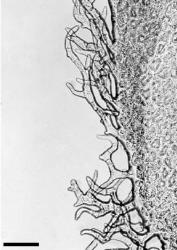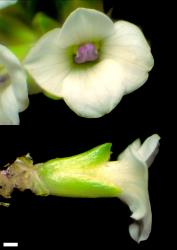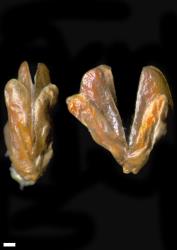- ≡ Hebe pauciflora G.Simpson & J.S.Thomson, Trans. & Proc. Roy. Soc. New Zealand 73: 166 (1943)
- ≡ Leonohebe pauciflora (G.Simpson & J.S.Thomson) Heads, Bot. Soc. Otago Newsl. 5: 10 (1987)
Spreading low shrub to 0.2 m tall. Stems decumbent to erect, eglandular-pubescent or glabrous; hairs bifarious. Leaf bud distinct, its outer leaves fully grown, diverging but leaving a broad, acute sinus at the base. Leaves opposite-decussate, erecto-patent to spreading; lamina coriaceous, rigid, ovate to rhomboid or spathulate or orbicular, 2–6 mm long, 2–6 mm wide, glossy pale green or yellowish to dark green above and beneath, weakly keeled but veins not evident; surfaces glabrous; margins eglandular-pubescent with long, tangled and often branching hairs, sometimes glabrous or finely papillate, entire, translucent, cartilaginous; apex obtuse to sub-acute or bluntly sub-apiculate; base cuneate; petiole broad, 1–2 mm long. Inflorescence a lateral spike or raceme, 6–14 mm long; flowers crowded, 2–4 or sometimes solitary, all bisexual; bracts opposite-decussate, connate, lanceolate to deltoid, > pedicels; pedicels erecto-patent, 0–1 mm long, glabrous or eglandular-hairy all around. Calyx lobes 4, acute, 4–6 mm long, sub-equal, eglandular-ciliate with tangled branching hairs. Corolla 6–9 mm diameter; tube white, 3–4 mm long, ≥ calyx, glabrous; lobes 4, white, spreading to recurved, sub-equal, elliptic to orbicular, 3.0–4.5 mm long, obtuse to rounded; nectar guides absent. Stamen filaments white, 1.5–2.0 mm long; anthers pink, magenta, or purplish. Style 1.8–3.0 mm long. Capsule angustiseptate, truncate to didymous, glabrous, 4.5–5.0 mm long, 4 mm at widest point. Seeds ellipsoid, weakly flattened, smooth, pale brown, 1.0–1.5 mm long.
Veronica notialis is a very distinctive species. In habit the plants resemble plants of the V. odora group and “Connatae”, but the angustiseptate capsules distinguish V. notialis. No other species is characterised by sinuous branching hairs on the leaf margins, although some whipcord hebes have very similar sinuate but unbranched hairs. The thick, translucent, cartilaginous cuticle on the leaves is also distinctive; through the dissecting microscope the leaf appears as if embedded in amber, especially at the margins.
Plants of V. murrellii and V. petriei have a similar habit to V. notialis plants, but differ in their softer dull or only slightly glossy leaves, which have a glabrous or minutely ciliolate margin, terminal, many-flowered inflorescences, narrower corolla lobes, and latiseptate acute to acuminate capsules.
South Island: Fiordland (mostly near and west of the main divide south of Caswell Sound).
Alpine grassland. Recorded elevations range from 1100 to 1500 m.
Flowers: December–March; fruits: January–March.
2n = 42 (see Bayly & Kellow 2006, as Hebe pauciflora).
Veronica notialis is classified in V. subg. Pseudoveronica sect. Hebe and the informal group “Pauciflorae” (Albach & Meudt 2010; Bayly & Kellow 2006).
Chromosome number, broad, rounded corolla lobes, and angustiseptate capsules suggest V. notialis may be a lineage attached at a basal node within the New Zealand clade, and this is borne out by unpublished DNA sequence data collected by E.M. Low, which place it as sister to the rest of the shrubby hebe clade, close to the attachment of two other southern species with a similar overall appearance, V. petriei and V. murrellii .



